Do you know where you water comes from? Ellie and I now know where our drinking water in Anchorage comes from! At the encouragement of Arctic Glacial Lakes collaborators, we visited Eklutna Water Treatment Facility, the provider of most of Anchorage's tap water. The facility is below Eklutna Lake, the low latitude lake of the Arctic Glacial Lakes project.
Foreman Brad Stitzel took time out of his day to take us on a fascinating tour. We wandered through huge concrete rooms containing giant pools and pipes that you could stand in, shouting over the rushing water to explaining each step that brings water from a glacial lake to someone's kitchen sink.
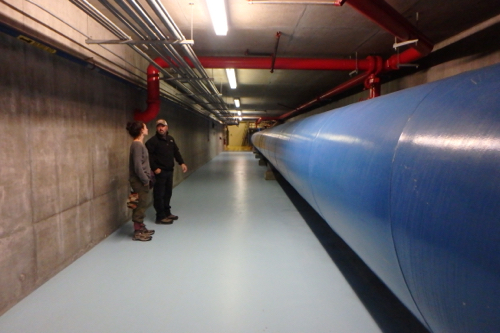 Ellie and Brad Stitzel discuss the water flowing into Eklutna Water Treatment Facility through the giant blue pipes.
Ellie and Brad Stitzel discuss the water flowing into Eklutna Water Treatment Facility through the giant blue pipes.
The biggest obstacle to purifying water is something very familiar to a glacial hydrologist: sediment. The fine glacial flour that makes glacial lakes turquoise settles very slowly and quickly clogs filters. The facility uses chemistry, adding positively charged compounds to the negatively charged lake water. Sediments can then clump, forming silt "snowflakes" which are heavy enough to sink to the bottom of giant concrete tanks.
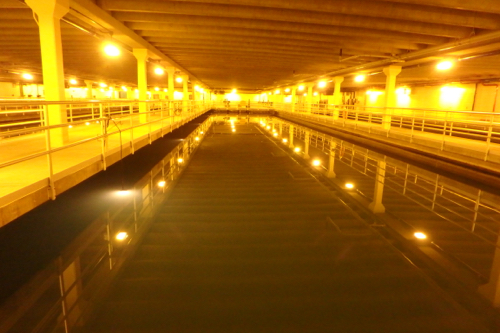 After special chemicals are added, sediments coagulate and settle to the bottom of concrete storage tanks as the water slowly flows through Eklutna Water Treatment Facility.
After special chemicals are added, sediments coagulate and settle to the bottom of concrete storage tanks as the water slowly flows through Eklutna Water Treatment Facility.
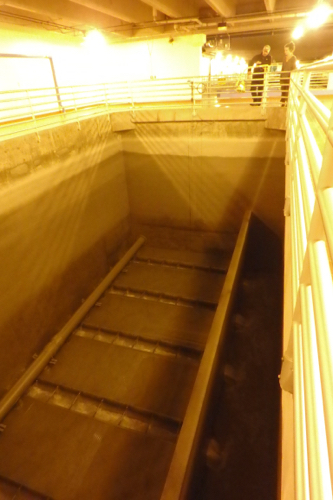 A filter is backwashed, meaning sediment is rinsed out, at the Eklutna Water Treatment Facility.
A filter is backwashed, meaning sediment is rinsed out, at the Eklutna Water Treatment Facility.
After most of the sediments settle, the water passes through a filter made of anthracite coal, gravel, and sand to remove the tiniest of sediments, much like infiltration removes impurities in nature. As the final step, chlorine is added to kill any bacteria. Since the Eklutna facility is downhill from the lake, the water's flow can generate more than enough energy for the plant, saving ~$23,000 a month in electricity! Employees carefully calibrate every step to avoid waste of chemicals, energy, and water and test the water every two hours to ensure Anchorage residents get the cleanest water possible. And they do – Eklutna has won many awards for their water quality, and many bottled water companies purchase water from the facility to sell in plastic bottles!
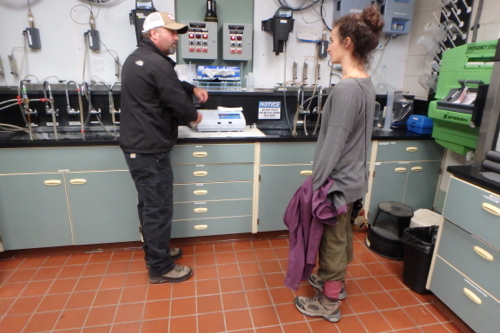 The water at Eklutna Water Treatment Facility is tested every two hours.
The water at Eklutna Water Treatment Facility is tested every two hours.
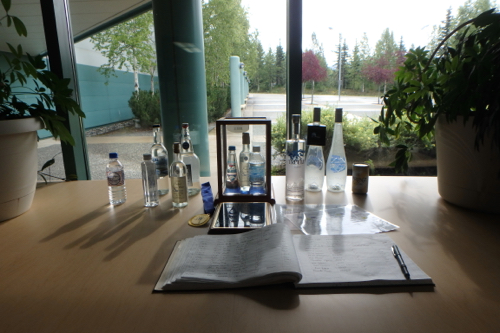 A sampling of bottled water that comes from the Eklutna Water Treatment Facility – Anchorage residents get it from their tap.
A sampling of bottled water that comes from the Eklutna Water Treatment Facility – Anchorage residents get it from their tap.
Brad and other employees understand chemistry, engineering, and hydrology. Because of their constant monitoring, they are very in tune with the glacial lake system, understanding how turbidity changes day by day, and how changes to the glacier can change the water in the lake. After the tour, Ellie and I drove to Eklutna for a quick hike along the shore. I never get sick of the bright milky blue of glacial waters, and it was fascinating to see another project site. The comparison between the two – Lake Peters in pristine Arctic wilderness, Eklutna thirty minutes from Alaska's largest city and providing drinking water for 300,000 people – gave me a better understanding of the scope of the project and the complexity of glacial lake systems.
 Rebecca Harris poses next to another Arctic Glacial Lakes site – Eklutna Lake.
Rebecca Harris poses next to another Arctic Glacial Lakes site – Eklutna Lake.

Add new comment